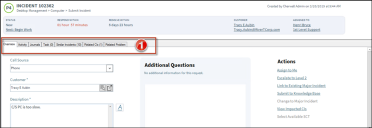Form Arrangements
A form arrangement is a tabbed collection of child forms and records that can be dynamically displayed on a parent form/record to convey related information.
A form arrangement can display:
- A form from any configured relationship: For example, the Incident Business Object is often in a relationship with the Journal, Configuration Item, and Problem Business Objects, so any of those forms/records can be displayed in the Incident's Form Arrangement. If a form/record in the form arrangement is in an owned by relationship with the parent form/record (example: Incident Owns Journals), then it can by edited; however, forms/records in linked relationships (example: Incident Links Problem) are read-only.
- Any form created for the same Business Object: For example, Incident has several forms that display Incident fields in different ways (example: Resolution Details, Incident Details, etc.), so any of these Incident forms can be displayed on the main (default) Incident form.
This is useful for displaying summary information, a subset of information, or information that is not always visible (example: Details from an embedded form).
A typical form arrangement might include:
- Journals: Track what occurs during the lifecycle of a record (example: Notes and history).
- Approvals: Track approving/denying/abstaining content by one or more designated users or teams.
- Configuration Items: Track managed assets that make up the CMDB.
- Knowledge Articles: Track records that share knowledge (example: FAQs, how-tos, workarounds/solutions, tutorials, processes, reference, etc.) among users and customers.
- Announcements: Track announcements with customers and/or other users.
The following figure shows an example Incident form with its form arrangement (1). The Incident Form Arrangement contains important data related to an Incident (example: Journals, Tasks, Resolution Details, Problems, etc.).
Managing Content-Protected Form Arrangements
If you are working with form arrangements that were previously applied as part of a Protected mApp™ Solution:
- You see a shield icon
 next to all content-protected relationships.
next to all content-protected relationships. - You cannot edit or delete a content-protected form arrangement.
- You can create and edit new Form Tab relationships on content-protected Forms using the Form Arrangement Editor.
- You cannot edit or delete content-protected relationships but you can create new relationships that you can edit and delete.
